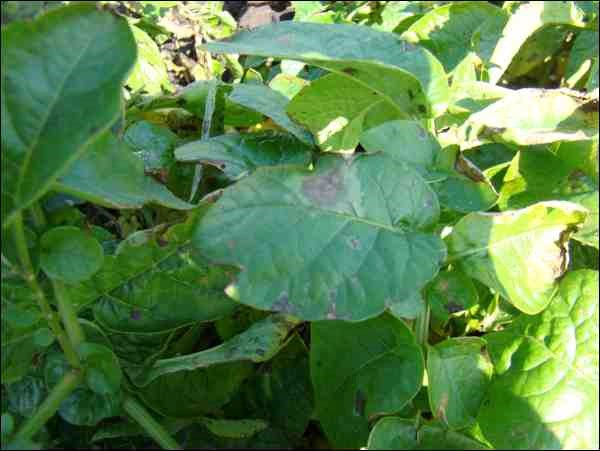Do you remember when Saskatchewan summers were so dry that growing a vegetable garden was nearly impossible without a good sprinkler working all spring, summer and fall. The last few years have been anything but dry.
Once again, the wet conditions are providing the perfect conditions for the formation and spread of late blight (caused by the fungus Phytophthora infestans) in potatoes and tomatoes. This is the same fungus that was responsible for the Irish potato famine leading to the subsequent Irish diaspora. It is still a significant crop disease, causing over $6 billion in losses annually.
Although it is often associated with potatoes, Phytophthora infestans attacks many plants in the Solanaceous family including tomato, eggplant, pepper (less likely) and nightshade. The disease was recently reported in the Outlook and Saskatoon areas.
Late blight thrives in cool damp weather. Late blight spores spread via the wind and rain splash. The spores thrive, survive and develop under high humidity, temperatures below 24 C and free moisture (i.e. rain, dew, mist) for at least six to eight hours. Late blight initially appears as a small dark lesion on the stem or leaf. Initial leaf lesions often occur lower in the plant canopy where there is less air movement and humidity is higher.
In cool, humid weather, these leaf lesions may occur on the upper canopy of the plant. Leaf lesions are: pale green to brown to grayish- black in color; circular or irregularly shaped; have a characteristic yellow or water-soaked "halo" surrounding the lesion. Unlike early blight (Alternaria solani), the lesions are not limited by leaf veins and will quickly encompass the entire leaf if conditions are favourable.
During cool damp weather or in the early morning, a white velvety growth can be seen on the underside of the leaves (the spores are produced on this growth). Stem lesions will continue to progress even during hot, dry weather. Under favourable conditions, large potato or tomato fields can be destroyed in several days.
If you suspect that you have late blight, remove the infected plant as soon as possible. Bury or burn infected leaves, stems and vines as soon as possible. Harvest potato tubers as you use them; otherwise, leave tubers in the soil as long as possible. Infected tubers will hopefully rot in the ground before you dig them for storage. Potato tubers infected by late blight will have brown to reddish or purple irregular sunken lesions on the skin. Under the lesions will be a reddish brown dry, granular rot that will continue to spread into healthy tissue. The entire tuber will eventually become infected and invaded by secondary soft rots. Monitor potato tubers in storage closely for rot. Dispose of rotting tubers immediately and clean and disinfect storage area with 10 per cent bleach solution.
Tomato fruit that looks healthy but has been harvested from infected plants should be washed in soap and water and dipped in a 10 per cent bleach solution followed by another soap and water wash. While this does not guarantee that your fruit won't rot, it may help to reduce infection if spores are located on the surface.
Tomato fruit that has been infected with late blight will have firm brown leathery spots on the exterior of the fruit, particularly on the shoulders of the fruit. These spots will eventually become a soft rot as other secondary rotting organisms invade the fruit.
To avoid future late blight infections, use drip irrigation to water plants to avoid water splash on the leaves. If you overhead water, avoid watering in the evening or at night. Destroy all volunteer tomato or potato plants that may emerge in your compost or surrounding garden area. Apply copper sprays as a preventative measure and control nightshade weeds.
Bantle is a horticulturist living in Saskatoon.
- This column is provided courtesy of the Saskatchewan Perennial Society (www.saskperennial.ca; [email protected]). Check out our Bulletin Board or Calendar for upcoming horticulture events: Labour&Learn at the Forestry Farm; Plant & Seed Exchange.




